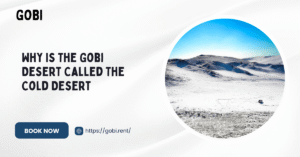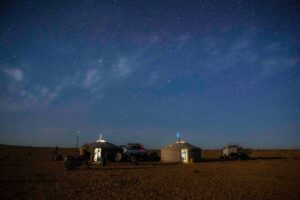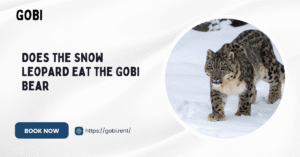When travelers picture Mongolia’s vast Gobi Desert, they often imagine endless dunes, rocky mountains, and rugged landscapes where only the toughest creatures survive. Two of the most fascinating animals found here are the snow leopard and the Gobi bear. Both are incredibly rare, both adapted to extreme conditions, and both capture the curiosity of scientists and visitors alike. A common question arises: does the snow leopard eat the Gobi bear?
The short answer is no. But the reasons why this is the case take us deep into the survival strategies of two of Mongolia’s most iconic species.
The Harsh Ecosystem of the Gobi Desert
The Gobi Desert is one of the largest deserts in the world, stretching across Mongolia and China. Despite being known as a desert, it is not all sand dunes. Much of it is made up of rocky terrain, dry valleys, and mountains that experience scorching summers and bitterly cold winters.
In this environment, food is scarce, water is limited, and survival is difficult. Every species here has developed unique strategies to adapt to the extremes. That is what makes both the snow leopard and the Gobi bear so remarkable.
Why the Gobi is so unique for wildlife
- Temperatures range from above 40°C in summer to below -30°C in winter.
- Rainfall is minimal, creating a constant struggle for water.
- The mix of desert, steppe, and mountain ecosystems supports unusual species found nowhere else.
The challenge of food scarcity in desert habitats
Predators and herbivores alike must constantly move and adjust their diet. In such a fragile ecosystem, every meal counts, and this shapes the relationship between snow leopards and Gobi bears.
Introducing the Snow Leopard
Known as the “ghost of the mountains,” the snow leopard is an apex predator of Central Asia. With thick fur, powerful legs, and an incredible ability to blend into rocky landscapes, it survives in some of the harshest terrain on Earth.
These cats typically hunt wild sheep and goats such as ibex and argali, but they are opportunistic and will also take marmots, hares, and smaller mammals. Snow leopards rely heavily on stealth and ambush rather than chasing their prey over long distances.
How snow leopards hunt in rocky landscapes
- They stalk prey silently using natural camouflage.
- A powerful leap allows them to attack from above on cliffs and ridges.
- Hunts are not always successful, which makes conserving energy vital.
Diet and adaptability of snow leopards
Their diet is flexible but always focused on animals smaller and safer to hunt than themselves. This already provides a clue as to why a Gobi bear is not a target.
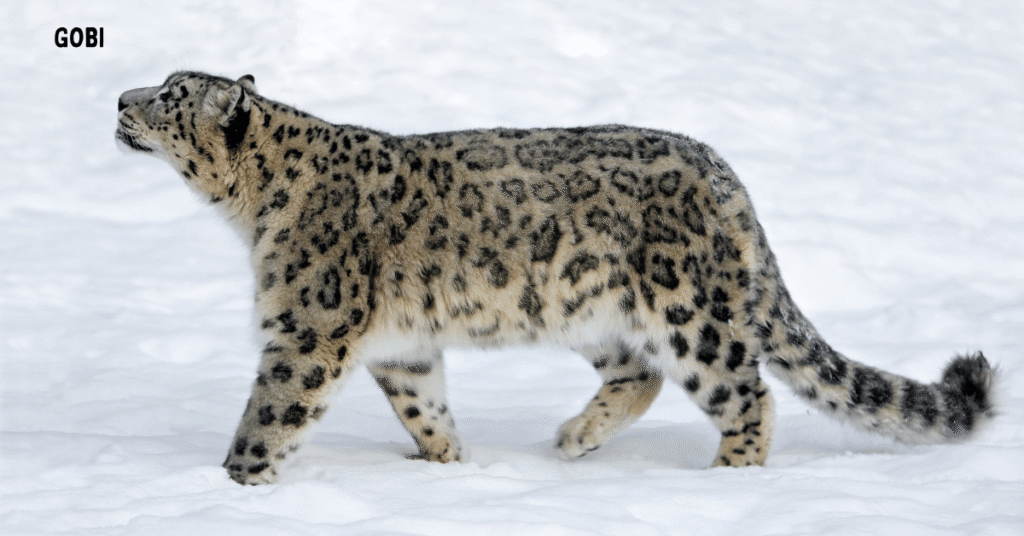
The Rare Gobi Bear
The Gobi bear, known locally as Mazaalai, is one of the rarest bears in the world. Estimates suggest fewer than 40 survive today, restricted to the Gobi Desert of Mongolia. Unlike most bears, these do not feed on large prey. Instead, they mostly survive on roots, berries, grasses, and insects. Occasionally, they may eat small rodents, but they are far from being hunters of large animals.
Cultural significance of the Gobi bear
Mazaalai are celebrated in Mongolia as symbols of resilience. They are considered a national treasure, with conservation efforts being a matter of pride.
Current conservation efforts for Mazaalai
- Strictly protected under Mongolian law.
- International programs track and monitor their population.
- Efforts are being made to improve food supply by planting berry bushes and other vegetation.
Do Snow Leopards Hunt the Gobi Bear?
The simple answer is no. There is no scientific evidence of snow leopards preying on Gobi bears. Several reasons explain this:
- Extreme rarity: With only a few dozen Gobi bears alive, encounters are unlikely.
- Risk vs reward: A bear, even a small one, is dangerous. Snow leopards usually target prey that cannot fight back with the same force.
- Dietary separation: Gobi bears are largely vegetarian, snow leopards are carnivorous. Their food needs rarely overlap in a way that would bring them into conflict.
Why predators rarely target other large carnivores
Predators generally avoid hunting each other because of the high risk of injury. For an animal like the snow leopard, one injury could mean starvation.
Food chain separation in the Gobi
Instead of competing, these two species coexist by focusing on different resources. This delicate balance helps both survive in a tough environment.
The Real Threats to Snow Leopards and Gobi Bears
Rather than facing danger from each other, both species share common threats caused by humans and climate.
- Habitat loss: Expanding livestock grazing reduces wild prey for snow leopards and plants for Gobi bears.
- Poaching: Illegal hunting for fur or body parts still affects snow leopards, while Gobi bears are at risk if they approach human settlements.
- Climate change: Reduced rainfall and hotter summers impact food availability for both.
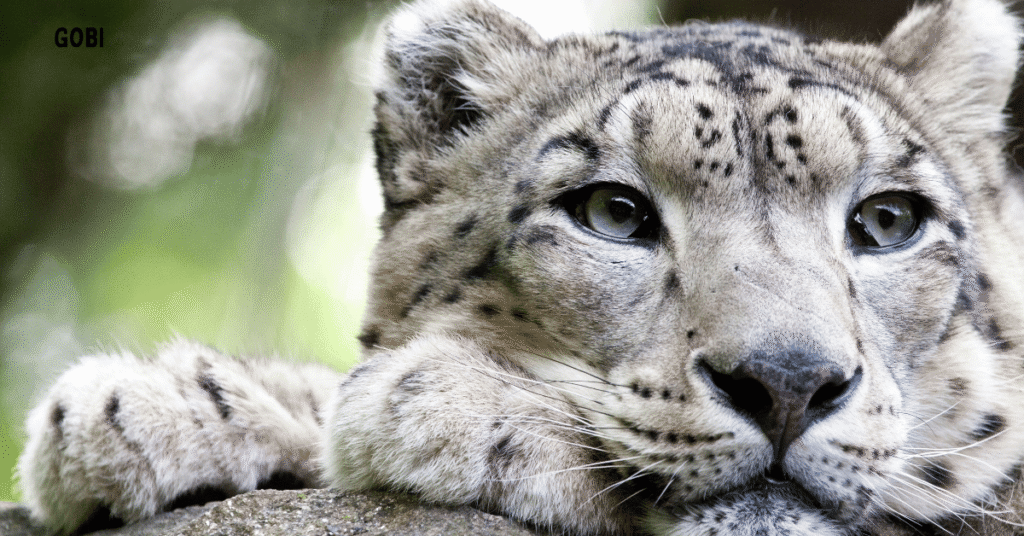
Shared conservation challenges
Both animals live in fragile ecosystems where even small disturbances can have big consequences.
International efforts in Mongolia
Conservation groups from around the world collaborate with local Mongolian rangers to protect habitats and reduce conflict with humans.
Conservation Programs in Mongolia
Mongolia has designated large parts of the Gobi Desert as protected areas. These zones limit human activity and provide safe space for wildlife.
Projects focused on snow leopard survival
- Satellite tracking to monitor populations.
- Community programs to reduce livestock–predator conflict.
Programs to save the Gobi bear
- Supplemental feeding programs in drought years.
- Monitoring dens and water sources.
- Raising awareness among local communities.
What Travelers Can Learn About Wildlife in the Gobi
Most travelers will never see a Orso del Gobi, and spotting a snow leopard is just as rare. But their presence makes Mongolia one of the most unique destinations for wildlife enthusiasts. Responsible travel helps preserve these species for future generations.
Wildlife encounters on a Mongolia self drive tour
- Seeing wild camels, gazelles, and ibex is far more common.
- Birdlife, such as eagles and vultures, is spectacular.
- Guides may share local stories about snow leopards and Mazaalai.
Eco-friendly practices for travelers
- Avoid littering in remote areas.
- Respect protected zones and water sources.
- Choose tour operators who support conservation programs.
Exploring the Gobi Desert with Gobi Rent
Adventure travelers exploring Mongolia often rely on sturdy vehicles to access remote areas. Gobi Rent provides premium Toyota Land Cruiser rentals, perfect for navigating the desert terrain. Whether you are planning a self drive Mongolia tour or joining a guided route through the South Gobi, having reliable transportation makes the experience safe and rewarding.
Self drive Mongolia tours for wildlife enthusiasts
- Flexibility to explore valleys, dunes, and mountain passes.
- Freedom to experience local nomadic culture along the way.
- Opportunity to learn about rare animals while respecting their habitats.
Why Toyota Land Cruisers are perfect for Gobi terrain
- High durability in desert conditions.
- Comfortable for long drives across rough landscapes.
- Equipped for off-road exploration where normal cars cannot go.
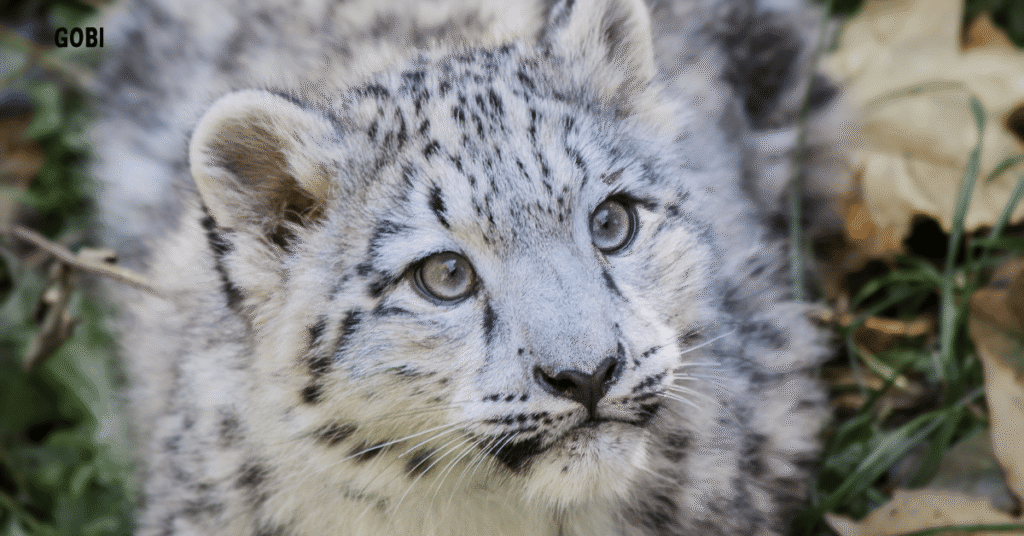
Conclusion
So, does the snow leopard eat the Gobi bear? The answer is no. These two rare species share the Gobi Desert but do not prey on each other. Instead, they survive in parallel, each with its own set of challenges. The real danger comes from human activity, climate shifts, and the delicate balance of their fragile ecosystem.
For travelers, learning about these animals is a reminder of how precious Mongolia’s wildlife is. By exploring responsibly and supporting local conservation efforts, visitors can play a role in protecting the “ghost of the mountains” and the last remaining Mazaalai.
And with the right vehicle from Gobi Affitto, your journey into the Gobi Desert can be both adventurous and respectful of the wild world that makes this region so special.


